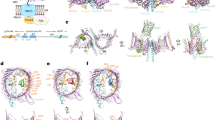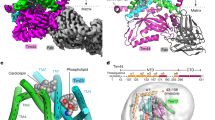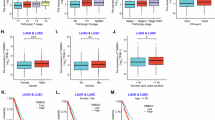Abstract
Mitochondrial protein import through the outer and inner membranes is key to mitochondrial biogenesis. Recent studies have explored how cells respond when import is impaired by a variety of different insults. Here, we developed a mammalian import blocking system using dihydrofolate reductase fused to the N terminus of the inner membrane protein MIC60. While stabilization of the dihydrofolate reductase domain by methotrexate inhibited endogenous mitochondrial protein import, it neither activated the transcription factor ATF4, nor was affected by ATAD1 expression or by VCP/p97 inhibition. On the other hand, notably, plugging the channel of translocase of the outer membrane) induced YME1L1, an ATP-dependent protease, to eliminate translocase of the inner membrane (TIM23) channel components TIMM17A and TIMM23. The data suggest that unoccupied TIM23 complexes expose a C-terminal degron on TIMM17A to YME1L1 for degradation. Import plugging caused a cell growth defect and loss of YME1L1 exacerbated the growth inhibition, showing the protective effect of YME1L1 activity. YME1L1 seems to play a crucial role in mitochondrial quality control to counteract precursor stalling in the translocase of the outer membrane complex and unoccupied TIM23 channels.
This is a preview of subscription content, access via your institution
Access options
Access Nature and 54 other Nature Portfolio journals
Get Nature+, our best-value online-access subscription
$32.99 / 30 days
cancel any time
Subscribe to this journal
Receive 12 print issues and online access
$259.00 per year
only $21.58 per issue
Buy this article
- Purchase on SpringerLink
- Instant access to full article PDF
Prices may be subject to local taxes which are calculated during checkout








Similar content being viewed by others
Data availability
Source data and mass spectrometry data are provided with this paper. All other data supporting the finding of this study are available from the corresponding authors on reasonable request. The MitoCarta 3.0 database (https://www.broadinstitute.org/mitocarta/mitocarta30-inventory-mammalian-mitochondrial-proteins-and-pathways) was used for proteomics data analysis. Proteomics from SILAC mass spectrometry has been deposited to the ProteomeXchange consortium with the dataset identifier PXD057163. Source data are provided with this paper.
References
Yamano, K., Kinefuchi, H. & Kojima, W. Mitochondrial quality control via organelle and protein degradation. J. Biochem. https://doi.org/10.1093/jb/mvad106 (2024).
den Brave, F., Pfanner, N. & Becker, T. Mitochondrial entry gate as regulatory hub. Biochim. Biophys. Acta Mol. Cell. Res. 1871, 119529 (2024).
Weidberg, H. & Amon, A. MitoCPR: a surveillance pathway that protects mitochondria in response to protein import stress. Science 360, eaan4146 (2018).
Martensson, C. U. et al. Mitochondrial protein translocation-associated degradation. Nature 569, 679–683 (2019).
Basch, M. et al. Msp1 cooperates with the proteasome for extraction of arrested mitochondrial import intermediates. Mol. Biol. Cell 31, 753–767 (2020).
Boos, F. et al. Mitochondrial protein-induced stress triggers a global adaptive transcriptional programme. Nat. Cell Biol. 21, 442–451 (2019).
Sim, S. I., Chen, Y., Lynch, D. L., Gumbart, J. C. & Park, E. Structural basis of mitochondrial protein import by the TIM23 complex. Nature 621, 620–626 (2023).
Fielden, L. F. et al. Central role of Tim17 in mitochondrial presequence protein translocation. Nature 621, 627–634 (2023).
Jin, S. M. et al. Mitochondrial membrane potential regulates PINK1 import and proteolytic destabilization by PARL. J. Cell Biol. 191, 933–942 (2010).
Baker, M. J. et al. Stress-induced OMA1 activation and autocatalytic turnover regulate OPA1-dependent mitochondrial dynamics. EMBO J. 33, 578–593 (2014).
Pfanner, N., Muller, H. K., Harmey, M. A. & Neupert, W. Mitochondrial protein import: involvement of the mature part of a cleavable precursor protein in the binding to receptor sites. EMBO J. 6, 3449–3454 (1987).
Metzger, M. B., Scales, J. L., Dunklebarger, M. F., Loncarek, J. & Weissman, A. M. A protein quality control pathway at the mitochondrial outer membrane. Elife 9, e51065 (2020).
Tanaka, A. et al. Proteasome and p97 mediate mitophagy and degradation of mitofusins induced by Parkin. J. Cell Biol. 191, 1367–1380 (2010).
Eilers, M. & Schatz, G. Binding of a specific ligand inhibits import of a purified precursor protein into mitochondria. Nature 322, 228–232 (1986).
Chen, Y. C. et al. Msp1/ATAD1 maintains mitochondrial function by facilitating the degradation of mislocalized tail-anchored proteins. EMBO J. 33, 1548–1564 (2014).
Okreglak, V. & Walter, P. The conserved AAA-ATPase Msp1 confers organelle specificity to tail-anchored proteins. Proc. Natl Acad. Sci. USA 111, 8019–8024 (2014).
Nuebel, E. et al. The biochemical basis of mitochondrial dysfunction in Zellweger Spectrum Disorder. EMBO Rep. 22, e51991 (2021).
Kim, J., Goldstein, M., Zecchel, L. & Weidberg, H. ATAD1 and the integrated stress response prevent clogging of TOM and damage caused by un-imported mitochondrial proteins. Cell Rep. 43, 114473 (2024).
Pickles, S., Vigie, P. & Youle, R. J. Mitophagy and quality control mechanisms in mitochondrial maintenance. Curr. Biol. 28, R170–R185 (2018).
Guo, X. et al. Mitochondrial stress is relayed to the cytosol by an OMA1-DELE1-HRI pathway. Nature 579, 427–432 (2020).
Fessler, E. et al. A pathway coordinated by DELE1 relays mitochondrial stress to the cytosol. Nature 579, 433–437 (2020).
Deshwal, S., Fiedler, K. U. & Langer, T. Mitochondrial proteases: multifaceted regulators of mitochondrial plasticity. Annu. Rev. Biochem. 89, 501–528 (2020).
MacVicar, T. et al. Lipid signalling drives proteolytic rewiring of mitochondria by YME1L. Nature 575, 361–365 (2019).
Rainbolt, T. K., Atanassova, N., Genereux, J. C. & Wiseman, R. L. Stress-regulated translational attenuation adapts mitochondrial protein import through Tim17A degradation. Cell Metab. 18, 908–919 (2013).
Kaldi, K., Bauer, M. F., Sirrenberg, C., Neupert, W. & Brunner, M. Biogenesis of Tim23 and Tim17, integral components of the TIM machinery for matrix-targeted preproteins. EMBO J. 17, 1569–1576 (1998).
Sinha, D., Srivastava, S., Krishna, L. & D’Silva, P. Unraveling the intricate organization of mammalian mitochondrial presequence translocases: existence of multiple translocases for maintenance of mitochondrial function. Mol. Cell. Biol. 34, 1757–1775 (2014).
Busch, J. D., Fielden, L. F., Pfanner, N. & Wiedemann, N. Mitochondrial protein transport: versatility of translocases and mechanisms. Mol. Cell 83, 890–910 (2023).
Youle, R. J. Mitochondria—striking a balance between host and endosymbiont. Science 365, eaaw9855 (2019).
Song, J., Herrmann, J. M. & Becker, T. Quality control of the mitochondrial proteome. Nat. Rev. Mol. Cell Biol. 22, 54–70 (2021).
Itakura, E. et al. Ubiquilins chaperone and triage mitochondrial membrane proteins for degradation. Mol. Cell 63, 21–33 (2016).
Krakowczyk, M. et al. OMA1 protease eliminates arrested protein import intermediates upon mitochondrial depolarization. J. Cell Biol. 223, e202306051 (2024).
Zhou, X. et al. Molecular pathway of mitochondrial preprotein import through the TOM-TIM23 supercomplex. Nat. Struct. Mol. Biol. 30, 1996–2008 (2023).
Rainbolt, T. K., Lebeau, J., Puchades, C. & Wiseman, R. L. Reciprocal degradation of YME1L and OMA1 adapts mitochondrial proteolytic activity during Stress. Cell Rep. 14, 2041–2049 (2016).
Yamano, K. et al. Critical role of mitochondrial ubiquitination and the OPTN-ATG9A axis in mitophagy. J. Cell Biol. 219, e201912144 (2020).
Tian, R. et al. CRISPR interference-based platform for multimodal genetic screens in human iPSC-derived neurons. Neuron 104, 239–255 e212 (2019).
Kanfer, G. et al. Image-based pooled whole-genome CRISPRi screening for subcellular phenotypes. J. Cell Biol. 220, e202006180 (2021).
Acknowledgements
We thank D. Narendra for thoughtful reading of the manuscript and the Youle laboratory for feedback. We also thank the National Institute of Neurological Disorders and Stroke (NINDS) Light Imaging Facility, National Heart, Lung, and Blood Institute Flow Cytometry Core Facility and NINDS Protein/Peptide Sequencing Facility for technical assistance. We thank T. Langer for the YME1L1 KO HeLa cells and H. Takahashi for the pEU-E01-MCS(C1)-His vector. This work was supported by the NINDS intramural program, the National Taiwan University startup funding (grant number 111L7475, 2022) (to M.-C.H.), the National Science and Technology Council Grant (112-2320-B-002-061 to M.-C.H.), Nanken-Kyoten TMDU (2024-kokusai12) (to K.Y.) and the JSPS KAKENHI grants 22H02577 and 23H04923 (to K.Y.).
Author information
Authors and Affiliations
Contributions
M.-C.H., K.Y. and R.J.Y. designed the study. M.-C.H., H.K., L.L., R.K. and K.Y. performed the experiments. M.-C.H., H.K., L.L., R.K. and K.Y. analysed the data and/or its significance. M.-C.H., K.Y. and R.J.Y. wrote the paper with contributions from H.K. and L.L. M.-C.H., K.Y. and R.J.Y. acquired funding.
Corresponding authors
Ethics declarations
Competing interests
The authors declare no competing interests.
Peer review
Peer review information
Nature Cell Biology thanks Cole Haynes, Thomas Becker, and the other, anonymous, reviewer(s) for their contribution to the peer review of this work. Peer reviewer reports are available.
Additional information
Publisher’s note Springer Nature remains neutral with regard to jurisdictional claims in published maps and institutional affiliations.
Extended data
Extended Data Fig. 1 The immunofluorescent staining of IDF with anti-DHFR antibody.
HeLa6-TetOn-IDF cells prepared as in Fig. 1b were analysed by immunofluorescent staining with anti-DHFR antibody. All images are representative of at least two independent experiments and were shown as Z-projected results.
Extended Data Fig. 2 IDF-MTX complex does not dissipate the mitochondrial membrane potential.
(a) HeLa6-TetOn-IDF cells were treated with DMSO or Dox/MTX for 24 hours or further treated with CCCP for the last 1 hour. Mitochondrial membrane potential was visualized with TMRE staining. DIC, differential interference contrast. Bars, 50 μm. All images are representative of at least two independent experiments. (b) Quantification of TMRE signals in (a). The TMRE-positive area values per cell were shown as jittered dots. The data were obtained from two independent experiments (n=207 for DMSO, n=225 for Dox/MTX, n=206 for Dox/MTX+CCCP=206). Horizontal lines are displayed as the median. Statistical significance was assessed by one-way ANOVA with Dunnett’s multiple comparisons test (ns, not significant; *** p<0.001). Source numerical data are available in source data.
Extended Data Fig. 3 VCP/p97 does not remove the mature IDF-MTX complex from mitochondria.
(a) HeLa6-TetOn-IDF cells were treated with Dox or Dox/MTX for the indicated times. The cell lysates were analysed by IB. p, precursor; m, mature form. All blots are representative of three independent experiments. (b) HeLa6-TetOn-IDF cells were treated with the indicated reagents and times. The cells (Total) were fractionated into mitochondrial (Mito) and cytosolic (Cyto) fractions, and analysed by IB. d, degraded intermediate of IDF. NMS-873, a VCP/p97 inhibitor. All blots are representative of two independent experiments. (c) HeLa6-TetOn-IDF cells were treated with the indicated reagents and times. The cell lysates were analysed by IB. All blots are representative of two independent experiments. Unprocessed blots are available in source data.
Extended Data Fig. 4 IDF plugging does not induce PINK1 stabilization.
HeLa6-WT and HeLa6-TetOn-IDF cells were treated with the indicated reagents and times. The cell lysates were analysed by IB. All blots are representative of two independent experiments. O/A, oligomycin and antimycin A; Epo, epoxomicin. Unprocessed blots are available in source data.
Extended Data Fig. 5 IDF plugging induces selective degradation of TIMM17A and TIMM23.
(a) The cell lysates prepared as in Fig. 5b were analysed by IB with antibodies against TOM subunits and TIMM50. All blots are representative of four independent experiments. (b) Volcano plot representation of the change in the putative YME1L1 substrates upon IDF plugging. The quantitative proteomic data was the same as in Fig. 5a but with different annotations. Class I proteins are the 29 putative YME1L1 substrates that are downregulated under hypoxic conditions; Class II proteins are the remaining 35 putative YME1L1 substrates that accumulated in YME1L1 KO MEF cells during normoxia. The annotation of YME1L1 substrates was retrieved from the previous report23. Unprocessed blots are available in source data.
Extended Data Fig. 6 Relationship between IDF-dependent TIMM17A degradation and mTOR activity or the imbalance of mitochondria DNA- and nuclear-encoded proteins.
(a) HeLa6-TetOn-IDF cells were treated with the indicated reagents for 24 hours. The cell lysates were analysed by IB. All blots are representative of three independent experiments. (b) Quantification of p-S6K (Ser371), TIMM17A and TIMM23 in (a) determined by densitometry. For p-S6K (Ser371), the blot densities were normalized first to total S6K and subsequently to DMSO treatment (lane 1). For TIMM17A and TIMM23, the blot densities were normalized first to HSP90 and subsequently to DMSO treatment (lane 1). The bars are displayed as mean ± SD from n=3 independent experiments. Statistical analysis was assessed by one-way ANOVA with Dunnett’s multiple comparisons test (* p<0.05; ** p<0.01; ns, not significant). (c) HeLa6-TetOn-IDF cells were treated with Dox/MTX or chloramphenicol (Cam) for 24 hours. The cell lysates were analysed by IB. All blots are representative of three biological replicates. (d) Quantification of YME1L1, TIMM17A, TIMM23 and ATF4 in (c) determined by densitometry, normalized first to HSP90 and subsequently to untreatment (lane 1). The bars are displayed as mean ± SD from n=3 independent experiments. Statistical analysis was assessed by one-way ANOVA with Dunnett’s multiple comparisons test (** p<0.01; *** p<0.001; ns, not significant). Source numerical data and unprocessed blots are available in source data.
Extended Data Fig. 7 Mitochondrial localization of FLAG-tagged TIMM17A and TIMM17B.
pBABE-EGFP-P2A-TIMM17 stable HeLa cells were analysed by immunofluorescent staining with anti-FLAG and TOMM20 antibodies. Bars, 10 μm. All images are representative of two independent experiments.
Extended Data Fig. 8 Overexpression of mitochondrial bipartite signals fused to DHFR induce YME1L1-dependent TIMM17A degradation.
(a) Schematic illustration of Dox-inducible proteins consisting of hDHFR and the indicated N-terminal mitochondrial precursors that contain a bipartite signal of mitochondrial targeting sequence (MTS) and a single transmembrane domain (TMD). MIC60 is identical to IDF (Fig. 1a). PISD is a mitochondria-localized enzyme that converts phosphatidylserine to phosphatidylethanolamine (UniProt: Q9UG56). DHODH has an uncleavable MTS at the N terminus followed by TMD anchored to IMM (UniProt: Q02127), and SCO2 is known as a cytochrome c oxidase assembly factor (UniProt: O43819). (b) WT and YME1L1 KO (KO) HeLa cells stably expressing the indicated construct were treated with or without Dox/MTX for 24 hours. The cell lysates were analysed by IB. All blots are representative of three independent experiments. p, precursor; m, mature. Asterisks denote DHFR moieties partially degraded or translated from a second methionine or later. (c) Quantification of TIMM17A (n=3 independent experiments) in (b) determined by densitometry, normalized first to Actin and subsequently to untreated for each substrate. The bars are displayed as mean ± SD. Statistical analysis was assessed by one-way ANOVA with Dunnett’s multiple comparisons test (* p<0.05; ** p<0.01; *** p<0.001). Source numerical data and unprocessed blots are available in source data.
Supplementary information
Supplementary Table 1
MS data file related to Fig. 5a.
Supplementary Table 2
Materials including antibodies, cells, plasmids etc.
Source data
Source Data Fig. 1
Unprocessed western blots.
Source Data Fig. 1
Statistical source data.
Source Data Fig. 2
Unprocessed western blots.
Source Data Fig. 2
Statistical source data.
Source Data Fig. 3
Unprocessed western blots.
Source Data Fig. 3
Statistical source data.
Source Data Fig. 4
Unprocessed western blots.
Source Data Fig. 4
Statistical source data.
Source Data Fig. 5
Unprocessed western blots.
Source Data Fig. 5
Statistical source data.
Source Data Fig. 6
Unprocessed western blots.
Source Data Fig. 6
Statistical source data.
Source Data Fig. 7
Unprocessed western blots.
Source Data Fig. 7
Statistical source data.
Source Data Fig. 8
Unprocessed western blots.
Source Data Fig. 8
Statistical source data.
Source Data Extended Data Fig. 2
Statistical source data.
Source Data Extended Data Fig. 3
Unprocessed western blots.
Source Data Extended Data Fig. 4
Unprocessed western blots.
Source Data Extended Data Fig. 5
Unprocessed western blots.
Source Data Extended Data Fig. 6
Unprocessed western blots.
Source Data Extended Data Fig. 6
Statistical source data.
Source Data Extended Data Fig. 8
Unprocessed western blots.
Source Data Extended Data Fig. 8
Statistical source data.
Rights and permissions
About this article
Cite this article
Hsu, MC., Kinefuchi, H., Lei, L. et al. Mitochondrial YME1L1 governs unoccupied protein translocase channels. Nat Cell Biol 27, 309–321 (2025). https://doi.org/10.1038/s41556-024-01571-z
Received:
Accepted:
Published:
Issue date:
DOI: https://doi.org/10.1038/s41556-024-01571-z
This article is cited by
-
Mitochondrial protein import stress
Nature Cell Biology (2025)
-
Molecular machineries and pathways of mitochondrial protein transport
Nature Reviews Molecular Cell Biology (2025)



